Ship of Fools Blu-ray Movie
HomeShip of Fools Blu-ray Movie 
Mill Creek Entertainment | 1965 | 149 min | Not rated | No Release Date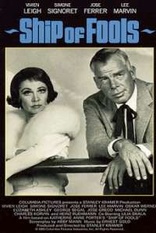
Price
Movie rating
6.9 | / 10 |
Blu-ray rating
| Users | 0.0 | |
| Reviewer | 3.5 | |
| Overall | 3.5 |
Overview
Ship of Fools (1965)
Based on the novel by Katherine Ann Porter. Passengers on a ship traveling from Mexico to Europe in 1933 represent society at large in that era.
Starring: Vivien Leigh, Simone Signoret, José Ferrer, Lee Marvin, Oskar HomolkaDirector: Stanley Kramer
| Drama | Uncertain |
| Romance | Uncertain |
| War | Uncertain |
Specifications
Video
Video codec: MPEG-4 AVC
Video resolution: 1080p
Aspect ratio: 1.85:1
Original aspect ratio: 1.85:1
Audio
English: DTS-HD Master Audio 2.0
Subtitles
English SDH
Discs
50GB Blu-ray Disc
Single disc (1 BD)
Playback
Region A (B, C untested)
Review
Rating summary
| Movie | 3.0 | |
| Video | 3.5 | |
| Audio | 3.5 | |
| Extras | 0.0 | |
| Overall | 3.5 |
Ship of Fools Blu-ray Movie Review
No One's Ark
Reviewed by Michael Reuben April 10, 2013The notion of a "ship of fools" dates from medieval times, when it was generally used as an allegory for those who had been abandoned by God or, after the Renaissance, reason. Adrift in a vessel without a pilot or destination, unaware of their condition, their fate was at the mercy of weather and tide. In 1962, American author Katherine Anne Porter used the title for her only novel, which was published after many delays to mixed reviews but excellent sales. Porter based the book on her own experiences in 1931 crossing the Atlantic to study on a fellowship in Germany. The film adaptation followed in 1965, with a screenplay by Abby Mann (Judgment at Nuremberg) and direction by Stanley Kramer (It's a Mad Mad Mad Mad World). The film was nominated for eight Oscars and won two (for cinematography, black-and-white, and art direction, black-and-white). Porter wrote primarily short stories, and the most common criticism of her novel was that it consisted of vignettes that didn't cohere into a whole. The same can be said of Mann's script, which substantially cut down the number of characters—too much, according to Porter—but retained enough for a big international cast that included Simone Signoret, José Ferrer, Lee Marvin, Oskar Werner, Elizabeth Ashley, George Segal and, in her last film, Vivien Leigh (playing a role originally intended for Katherine Hepburn). Films with multi-stranded narratives following several plots simultaneously may be common today, but they were a novelty when Ship of Fools appeared. Mann advanced the time period from 1931 to 1933, the year when the Nazis achieved a major electoral victory, which had the effect of making the danger more immediate as the ship and its passengers steamed from Mexico toward the German port of Bremerhaven. Meanwhile, each individual lived out his or her story, with greater or lesser awareness of the historical juggernaut rolling toward them all.

Ship of Fools is bookended by speeches directed to the camera by Glocken, a dwarf whose background is never explored but who is the ideal observer, because everyone treats him as an outsider. The actor, Michael Dunn, was nominated for an Oscar for the part, but he is best remembered as Dr. Miguelito Loveless on the TV show The Wild, Wild West (not to be confused with the Will Smith film "adaptation"). Glocken explains to the audience that everyone on the ship is a fool, and he is just one fool among many. Because he isn't "normal", Glocken is never extended the honor of being invited to dine at the table of the ship's captain, Thiele (Charles Korvin). Instead, he is exiled to a separate table with a Jewish salesman, Lowenthal (Heinz Ruehmann), who considers himself a German first and remains upbeat about the future. After all, he says, in one of the film's most loaded lines, there are a million Jews in Germany. It's not as if they can just kill "all of us". This being a German ship, one of the most voluble and expansive regulars at the captain's table is an enthusiastic supporter of National Socialist policies, a newspaper publisher named Rieber (José Ferrer). In his genial presentation, horrific policies such as eugenics sound reasonable and natural. But Rieber's true colors are revealed when he discovers that another German passenger with whom he has been dining for much of the voyage has a Jewish wife at home and has him exiled to the outcasts table with Glocken and Lowenthal, while Rieber watches in smug satisfaction. In an ironic turn, however, the ship's agent has lodged Rieber and Lowenthal as roommates sharing the same cabin. Because the ship is booked to capacity, Rieber cannot arrange a switch and is forced to share the entire voyage with a Jew. He does not achieve any new understanding of the race he despises, but the arrangement results in interesting exchanges. Passengers might not covet a spot at the captain's table if they knew how Captain Thiele felt about dining with them. He hates it and sends the ship's doctor, Schumann (Werner), in his place whenever possible. ("Schumann—isn't that a Jewish name?" wonders Rieber aloud at one point.) Werner, the star of François Truffaut's Jules et Jim and Fahrenheit 451, was nominated for an Oscar for his quietly memorable performance as a physician who left his family behind and put to sea searching for something he can't quite name. After a lifetime of doing the "right" thing, including attendance at the kind of elite educational institution where he received a prominent dueling scar on his face that, in Germany at that time, was considered a badge of honor, Dr. Schumann finds life to be without substance or meaning. Sailing the world, he hoped to find some but so far has not. A ray of light appears to Dr. Schumann in the unlikely form of La Condesa (Signoret, the third of the film's Oscar-nominated actors), the former mistress of a Spanish sugar plantation owner who is being returned home to serve a prison sentence because she agitated for change on behalf of field hands. She boards at the same time as several hundred such workers, who are treated as cargo and quartered on deck in steerage. The doctor meets La Condesa because she is addicted to narcotics and needs his assistance to ease withdrawal. They quickly strike up a relationship based on the mutual sharing of regret. It is a topic they both know well. A much different couple is David (George Segal) and Jenny (Elizabeth Ashley). He is a struggling painter with aspirations to become an artist of the proletariat, while she is the middle class daughter of a store owner who simply wants to have fun and is paying for the entire trip for both of them. They have animal attraction in common and little else. When they're not in bed together, they're quarreling. Perhaps the most difficult passenger to understand is an American divorcée, Mrs. Treadwell (Leigh), whose waspish exterior conceals a wild and crazy streak. After enduring years of a miserable marriage to a diplomat, Mrs. Treadwell seems unable to enjoy her new-found freedom, which includes all of her ex-husband's money, courtesy of the courts. As she talks about her life with various younger women, primarily Jenny, one senses how much she envies the fact that they have many possibilities still before them. She sees none for herself, especially when confronted with the attentions of a fellow American like Tenny (Marvin), who is the epitome of the crass American tourist. The mystery, however, is why Mrs. Treadwell is voyaging to Germany. In Porter's novel, she was returning to Paris to recapture her youth. In the movie, she just seems adrift. Director Kramer and his editor, Robert C. Jones (See No Evil, Hear No Evil, among many others), keep all these stories and various others criss-crossing and intertwining, so that Ship of Fools holds the viewer's attention and earns its long running time. But by the end, when Glocken turns to the camera and grinningly asks the audience what any of this has to do with them, the question doesn't land with the ironic impact that Abby Mann probably intended when he wrote the script. The pieces of the allegorical puzzle don't click solidly enough into place to provide the smooth surface in which we might see ourselves reflected. Maybe it worked better when the film was new, and audiences could still remember the experience of World War II—and also feel regret at not having acted sooner to counter the fascist threat. Today, however, the whole isn't greater than the sum of its parts. Indeed, it's somewhat less.
Ship of Fools Blu-ray Movie, Video Quality 
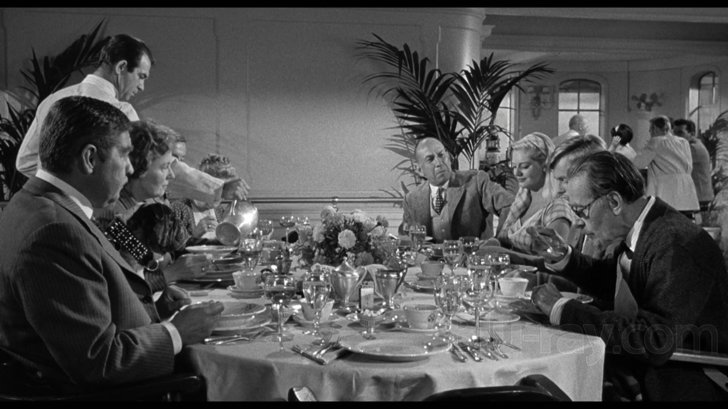
Despite a low bitrate and being crowded onto a BD-50 with another nearly two-hour film, Ship of Fools looks surprisingly good in Mill Creek's 1080p, AVC-encoded presentation. Much of the credit is due, I suspect, to a more recent transfer for the Stanley Kramer Film Collection DVD set released by Sony in 2008 and/or superior elements fewer generations removed from the original camera negative. The detail in Ernest Laszlo's Oscar-winning cinematography is generally exceptional, as are black levels and contrast. A flickering instability appears from time to time, presumably reflecting damage to the source element, but it is relatively minor. The transfer's biggest flaw is video noise, and although it is not as severe a phenomenon as on the accompanying feature, Lilith, it is certainly noticeable, especially in fine areas of detail. The noise may not be obvious in screencaps, since it is a function of pixels in motion, but it is definitely there, and its presence belies the application of any so-called "DNR", which would have obscured it. It's more likely that a degree of electronic sharpening was applied for the DVD crowd, and video noise is the unfortunate artifact. Occasionally, the noise resembled the old-fashioned "mosquito noise" that results from overcompression; if that is the cause, it is truly unfortunate, because ample space remains on this BD-50. There was no need to squash this two-hour, 29-minute film down to the smallest possible file size.
Ship of Fools Blu-ray Movie, Audio Quality 
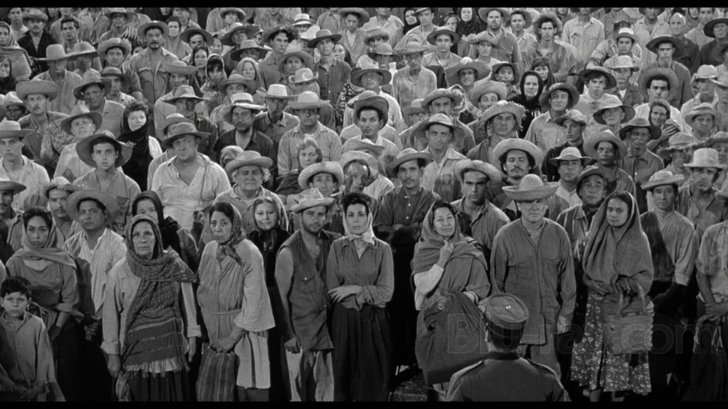
The film's original stereo soundtrack is included as DTS-HD MA 2.0, and it's impressive for a track of this vintage. The dynamic range in key sequences will make viewers sit up and take notice. The flamenco dance sequence is a notable example, as rhythmically stomping feet repeatedly strike the wooden floor with resounding claps. So, too, is the ironically upbeat band that welcomes the passengers upon their disembarkation at the final destination in Bremerhaven. For most of the voyage, however, sounds of shipboard life are relatively restrained by contrast to what would be heard on a contemporary soundtrack, and the emphasis is on dialogue, which is clearly rendered, except that some of the performers have unusually strong accents (Simone Signoret's is especially thick). The spare underscoring is by Oscar winner Ernest Gold (Exodus).
Ship of Fools Blu-ray Movie, Special Features and Extras 
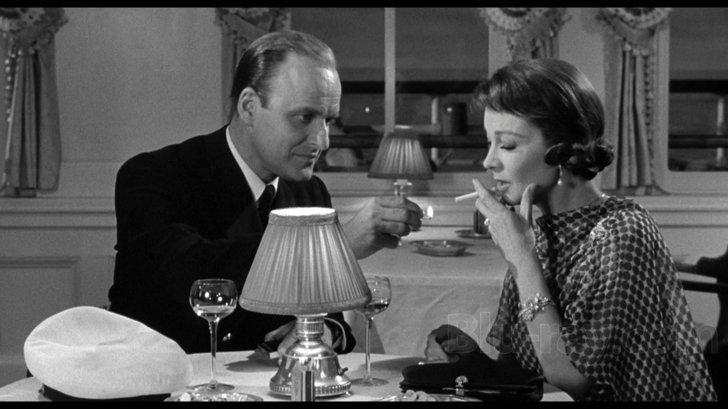
No extras are included. Sony's 2003 DVD also provided no extras. Sony re-released Ship of Fools on DVD in 2008 as part of the Stanley Kramer Film Collection, which included a separate bonus disc devoted to Kramer's career, but I have been unable to determine whether any specific extras were created for Ship of Fools.
Ship of Fools Blu-ray Movie, Overall Score and Recommendation 
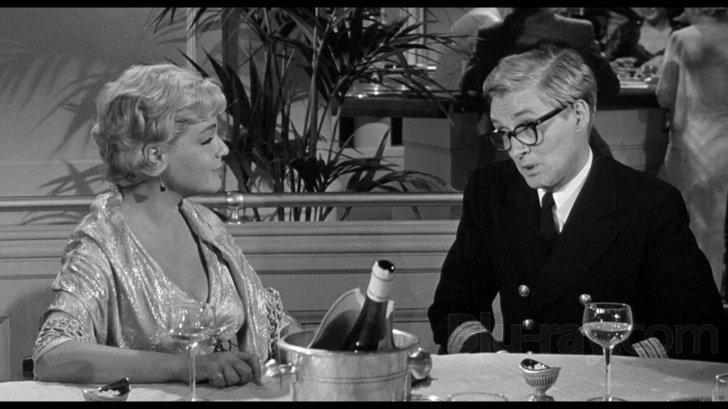
Ship of Fools was an ambitious undertaking, and I suspect it was probably a powerful film when it first appeared, but it hasn't aged well. Individual storylines and performances retain their impact, and the overarching concept is intriguing, but there's no overcoming the fundamental "design flaw" in Porter's original novel. Allegory is a tricky form of storytelling, and an author (or filmmaker) who relies on it too heavily to invest events with significance is more likely than not to be betrayed. Just seven years later, Bob Fosse's Cabaret achieved much the same effect for which Kramer was aiming with a much smaller cast of characters. Instead of sailing on a sea of allegory, Cabaret plunked itself down in Berlin and looked the monster directly in the face. More often than not, the direct approach is best. Recommended for the cast and their performances.
Similar titles
Similar titles you might also like
(Still not reliable for this title)

Forbidden
1932

Fanny
1961

The Woman Between
1931

Lilith
1964

Mrs. Miniver
1942

The Caine Mutiny
1954

A Letter to Three Wives
Fox Studio Classics
1949

Now, Voyager
1942

The Bitter Tea of General Yen
1933

Ladies of Leisure
1930

Kept Husbands
1931

Tabu: A Story of the South Seas
1931

The Miracle Woman
1931

Submergence
2017

Cleopatra
1934

The Four Feathers
1939

Grand Hotel
1932

In Which We Serve
1942

Morocco
1930

Hold Back the Dawn
Arrow Academy
1941